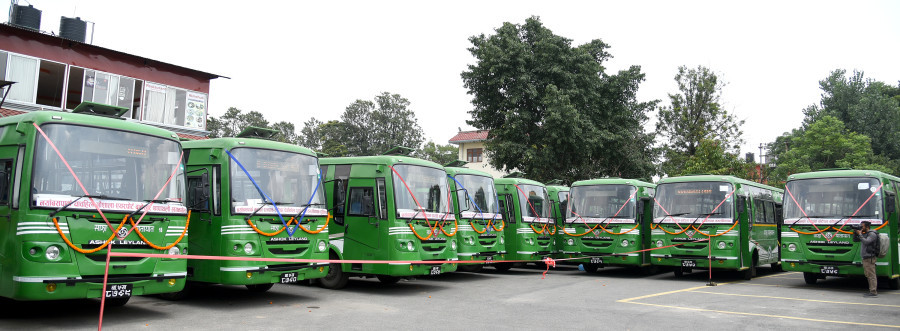Columns
Public transport for a livable community
A quality public transport system is a powerful tool for building a just, resilient, empathetic society.
Sagar Onta
Public transport is not glamorous, but it is essential to build a just, equitable and liveable community. That was one of the main conclusions of a two-day symposium on Transforming Public Transport in Southasia in Kathmandu on March 24-25, 2025. For the first time in Nepal, the symposium brought together approximately 100 professionals, operators, regulators, educators, students and advocates from Nepal, Australia, India, China, Pakistan and Sri Lanka to discuss critical public transport issues in the region. Held at the newly opened Sajha Southasia Centre in Pulchowk, the symposium was jointly organised by the Federal Capital City Public Transport Authority (FCCPTA) of Kathmandu Valley and Sajha Yatayat.
The symposium aimed to highlight the critical role of public transport in creating a community where residents can live healthy and meaningful lives and an economy that is sustainable and circular. A quality public transport system is a powerful tool for building a just, resilient and empathetic society. Whether it's the need to strengthen and operationalise the recently formed public transport authority in the valley or challenges faced by cross-border bus operators in renewing their one-year route permit that takes 11 months to obtain or update the higher education curriculum to align with the profession's demands, the symposium provided a platform to discuss current challenges and opportunities in the public transport system. It also allowed Sajha Yatayat to share their experience as the only bus operator running big e-buses in Nepal and compare its operation with regular internal combustion engine (ICE) buses. One of the key results was that Sajha’s e-buses were running at a profit of approximately Rs 1,900 daily, while their ICE buses were running at a daily loss of approximately Rs 4,400. Similarly, their analysis showed that running larger 11m e-buses is more profitable than smaller 8.5 m e-buses. It also revealed that a 20 percent subsidy on 11m e-buses has a return on investment of 10 percent and will break even in 10 years.
The symposium allowed the participants to learn from a respected public transport professional, Mr Alok Jain, the event's keynote speaker, who also participated in several discussions. Jain currently consults with governments worldwide on how to plan for, build and operate public transport systems. His key message was that the solution to improve the public transport system is not with experts in the room but with the bus drivers and operators of the bus system. The experts should translate their recommendations into actions by listening to them. He mentioned that widening roads or building flyovers cannot solve the ills of growing cities in Nepal, such as traffic congestion, air pollution, crashes, and so on. Investment in the public transport system is crucial to making cities liveable.
Similarly, presenters from Pakistan, India and China shared their experiences in developing public transport systems. Mr Arif Hasan, a prominent architect and planner from Pakistan, presented the history of public transport in Karachi. He advised Kathmandu to be cautious about relying heavily on foreign investment in the public transport system. Similarly, Ravi Gadepalli of Transit Intelligence, a consulting firm working on electrification and digitalisation of the public transport sector, shared learnings from India’s e-bus transition. He recommended transitioning from the current system of route licensing to fleet service contracts, developing a city-level bus route network, managing service contracts, monitoring the operators' performance and conducting feasibility research on leasing electric buses. Akshay Gattu of pManifold, an electric mobility consulting firm in India, gave training on e-bus financing and operation. Their case study of Pokhara showed that to procure a fleet of 53 9m e-buses without subsidy, the internal rate of return (IRR) will be 14.3 percent with a payback period of 5.5 years. However, with a subsidy of approximately $2 million, the IRR jumps to 23 percent and the payback period is reduced to 3.6 years. This shows the substantial impact subsidy will have in making e-bus procurement financially feasible for the private sector.
In recent years, a significant milestone in regulating the public transport sector has been the promulgation of the Urban Area Public Transport (Management) Authority Act of 2079. For the first time, the Act allows the formation of a Public Transport Authority (PTA) that has exclusive rights to manage and develop public transport systems in the country. While it allows the provincial government to establish such a PTA in Kathmandu Valley, the Act establishes the Federal Capital City Public Transport Authority (FCCPTA) through a special section. However, FCCPTA has not been fully functional in practice. The main reason is the lack of coordination between the three levels of government. The FCCPTA is formed by the federal government but is headed by the local government. As a result, it has been treated like a stepchild—unwanted by all government entities. The authority's success depends on it being embraced by all levels of government to provide quality service to the public.
Further, the FCCPTA governing council comprises 36 members, including 16 mayors or vice-mayors of various municipalities in the valley. This arrangement has made it almost impossible to call a meeting of such a sizeable body. Other aspects of the act have also hindered operation, including ambiguity on whether the authority can give route permits to operators, inability to generate operational funds and hire staff outside of the lok sewa process, especially for technical experts.
A high-level delegation from the University of New South Wales (UNSW) in Sydney who participated in the symposium brought a cutting-edge driver simulator developed by the Research Centre for Integrated Transport Innovation (rCITI). The open platform simulator allows practitioners to test the safety of intersections and roadway sections. In addition, hazardous scenarios, like landslides, diversions, etc., can also be programmed and tested. The highly customisable simulator can be a test bed for new technology. Furthermore, rCITI trusted Sajha Southasia Centre to keep the simulator to benefit researchers and practitioners in Nepal. This is likely the only simulator of its kind in the country.
In conclusion, the symposium provided a great platform for all public transport practitioners and researchers to exchange ideas and formulate mechanisms to improve the public transport system. Sajha Southasia Centre is committed to organising such events regularly to bring about the needed transformation of the Nepali public transport sector.




 15.47°C Kathmandu
15.47°C Kathmandu















